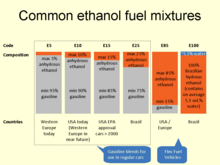
Back Gasohol Catalan Brændstofblandinger med ætanol Danish Ethanol-Kraftstoff German Gasohol Spanish Gasohol Basque Bioetanolove mješavine Croatian Campuran bahan bakar etanol umum ID Miscela di etanolo Italian ガソール Japanese Jenis campuran bahan api etanol Malay

Several common ethanol fuel mixtures are in use around the world. The use of pure hydrous or anhydrous ethanol in internal combustion engines (ICEs) is only possible if the engines are designed or modified for that purpose, and used only in automobiles, light-duty trucks and motorcycles. Anhydrous ethanol can be blended with gasoline (petrol) for use in gasoline engines, but with high ethanol content only after engine modifications to meter increased fuel volume since pure ethanol contains only 2/3 of the BTUs of an equivalent volume of pure gasoline. High percentage ethanol mixtures are used in some racing engine applications as the very high octane rating of ethanol is compatible with very high compression ratios.
Ethanol fuel mixtures have "E" numbers which describe the percentage of ethanol fuel in the mixture by volume, for example, E85 is 85% anhydrous ethanol and 15% gasoline. Low-ethanol blends are typically from E5 to E25, although internationally the most common use of the term refers to the E10 blend.
Blends of E10 or less are used in more than 20 countries around the world, led by the United States, where ethanol represented 10% of the U.S. gasoline fuel supply in 2011.[1] Blends from E20 to E25 have been used in Brazil since the late 1970s. E85 is commonly used in the U.S. and Europe for flexible-fuel vehicles. Hydrous ethanol or E100 is used in Brazilian neat ethanol vehicles and flex-fuel light vehicles and hydrous E15 called hE15 for modern petrol cars in the Netherlands.[2]
- ^ Renewable Fuels Association (2012-03-06). "Accelerating Industry Innovation - 2012 Ethanol Industry Outlook" (PDF). Renewable Fuels Association. Archived from the original (PDF) on 2012-05-14. Retrieved 2012-05-06. See pp. 10
- ^ Cite error: The named reference
BESTReportwas invoked but never defined (see the help page).